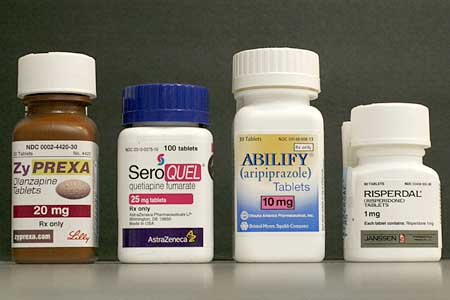Akathisia Definition
Page Contents
The Czech Neuropsychiatrist, Ladislav Haskovec was the one who had coined the term, ‘Akathisia’ for a sensory syndrome that is characterized by a constant restless feeling that does not allow one to be motionless or still. The term has been derived from a Greek word ‘kathizein’, meaning ‘to sit’ which comes along with an attached negative prefix to connote absence, thus implying ‘an inability to sit’.
Also known as Acasthisia, it is caused due to an increase in the neurotransmitter norepinephrine level that leads to increased levels of anxiety, aggression, arousal and alertness. It may also be associated with the disruption of NMDA receptors that are the predominant molecular device that controls the capacity to memorize and also handles the synaptic plasticity functions of norepinephrine. It can vary in its intensity from mild to severe depending on the cause and extent of the disorder. It is may exhibit symptoms akin to restless leg syndrome or fibromyalgia. Akathisia may be of a few types such as neuroleptic-induced akathisia, late-persisting or tardive akathisia and akathisia tardive dyskinesia.
Akathisia Symptoms
One may understand as to whether one suffers from acute akathisia or chronic akathisia, by the nature of symptoms that one exhibits. In any case, the symptoms of akathisia include an increasing discomfort, fatigue, muscle stiffness, hypertension, neuropathic pain, irresistible urge to move, and rhythmic leg movements at night, a condition known as periodic limb movement disorder (PLMD). One may also suffer from pacing in the knees, insomnia, nausea, and labile effect like weeping, poor concentration or attention, impatience and dysphoria which in case of acute akathisia may even force one to commit suicides. It is important to note that the symptoms of akathisia may worsen when one is suffers from emotional upheavals or stress related problems.
Akathisia Causes
The most basic cause behind the occurrence of akathisia may be attributed to the side-effects of antipsychotic drugs. The causes of akathisia may also include calcium channel blockers, buspirones, metoclopramides, and dopamine agents. A mention may be made of some of the causes of akathisia:-
Neuroleptic Antipsychotic Drugs
They include antiemetics like promethazine, metoclopramide; phenothiazines like chlorpromazine, perphenazine; butyrophenones like haloperidol (Haldol); thioxanthenes like zuclopenthixol, flupenthixol; piperazines like ziprasidone; and others namely, pimozide, asenapine (Saphris), droperidol, amisulpride, aripprazole (Abilify), trifluperazine and risperidone. Among these, zuclopenthixol (Cisordinol) and chlorpromazines such as Largactil are less sedating in nature. They possess antihistaminergic and anticholinergic qualities which aid to fight against akathisia.
Picture 1 – Antipsychopathic Drugs
Source – www.societyforhumanisticpsychology.blogspot.com
Selective Serotonin Reuptake Inhibitor (SSRIs)
They are a class of compounds typically used as anti-depressants which may by virtue of their side-effects cause SSRI Akathisia. SSRIs like paroxetine (Paxil), Zoloft, Xanax and fluoxetine (Prozac) are the main cause behind the suicidal tendencies that occur in case of Prozac akathisia. Zofron akathisia is also a product of this case.
Other Antidepressants
Beyond anti-psychopathic drugs and SSRIs, Antidepressants like tricycles, venlafaxine (Effexor) and venlafaxine may also trigger symptoms of akathisia. Moreover, trazodone akathisia may also be caused when one uses trazodone by the name of Desyrel.
Antiemetic Drugs
Dopamine blockers like prochlorperazine (Compazine), promethazine and metoclopramide (Reglan) are responsible for causing Reglan akathisia.
Antihistamines
Diphenhydramines and other cyproheptadines are some of the most potent antihistamines that cause akathisia.
Withdrawal from Physical Addictions
Withdrawal from different kinds of physical addictives such as barbiturates, cocaine, opioid, alcohol, benzodiazepine, and cannabis may cause withdrawal akathisia.
Amphetamines and Stimulants
Amphetamines under the brand names Vyvanse, Adderall, ProCentra, Dexedrine, Benzedrine, Dextrostat and Desoxyn and other stimulants such as tea or coffee may perpetuate the condition related to akathisia.
Chondromalacia Patellae (CMP)
This is a condition that causes pain at the front of the knees and usually affects young boys and girls who are into athletics and sports. It causes pain and discomfort when knees are bent. It is one of the basic reasons behind akathisia.
Serotonin Syndrome
This syndrome is related to excess serotonergic activity at CNS and also the PNS. It is basically caused by adverse drug reaction and may lead to cognitive, somatic and autonomic effects including akathisia.
Parkinson’s Disease
Akathisia may also caused by a brain disorder that has shows symptoms such as movement or locomotion disorders, difficulty in coordination, dementia, anxiety and body tremors. Parkinson’s disease may be blamed for causing chronic akathisia and the associated neurological disorders that may be triggered by the same. Sinemet, prescribed for dealing with Parkinson’s may also trigger akathisia.
Iron Deficiency
Deficiency of iron in the body may also cause akathisia and other related syndromes such as restless leg syndrome, fibromyalgia, etc.
Along with the aforementioned, akathisia may also be caused by dysphoria, hyperkinesis, and other syndromes or disorders related to kidney and neuropathic problems.
Akathisia Diagnosis
Since the symptoms of akathisia are quite similar to many a related diseases and syndromes such as Restless Leg Syndrome (RLS), Fibromyalgia, Nocturnal Myoclonus, etc. There is a high possibility for a misdiagnosis of akathisia in case of antipsychotic neuroleptic-induced akathisia. So a proper and differential diagnosis is important for detecting the cause of akathisia. However, one can detect the presence and the severity of akathisia with the help of Barnes Akathisia Scale, which is also called akathisia rating scale. Blood tests such as Serum ferritin and CBC may also be prescribed for detecting the possibility of iron deficiency in blood.
Akathisia Treatment
The basic objective behind the treatment of akathisia is to prevent the proliferation of its effects and to control the same. However, one has several optional ways of dealing with akathisia. These methods include either reducing the dose of the causative medication or even withdrawing from the medication or administering other drugs. The drugs that are normally prescribed are propranolol, clonazepam, benzodiazepines, benzatropine, cryproheptadine, Benadryl and trihexyphenidyl. Propranolol akathisia may be caused due to the administration of propranolol along with beta-blockers like metopropol. However, excessive use of Benadryl may be harmful for one’s health. N-acetyl cysteine has recently been tested positive for akathisia.
However, those suffering from neuroleptic-induced akathisia must have food rich in vitamin B6 as it helps in reducing the harmful repercussions of the disorder. Akathisia management also includes physical exercises to relax the muscles and reduce stress.
However, akathisia can be fatal if kept unchecked because it may perpetuate to cause paralysis or other nerve disorders. Moreover, the prognosis of the disorder is quite high. So an early diagnosis and treatment of the disorder is necessary to thwart the perilous effects that may even cripple one’s life permanently.
References
Wikipedia



That article seems a total mess, incomparable to almost anything else which is easily available by now.